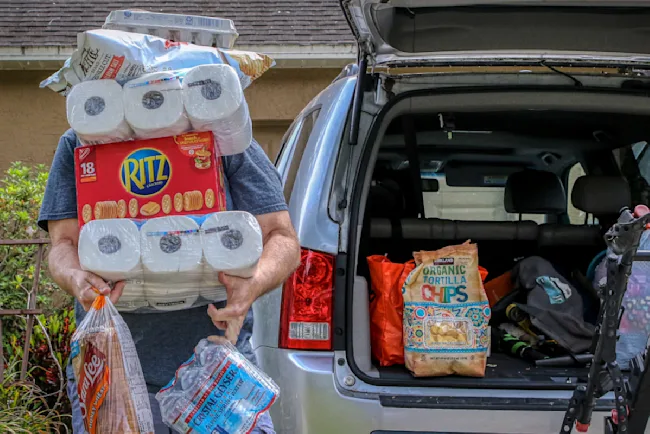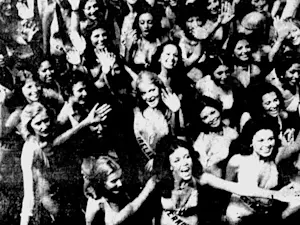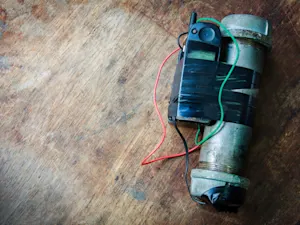
He Claimed to Be the Messiah. Then 76 Died in a Fiery Siege in Waco.
FBI photo of the Mount Carmel Center engulfed in flames on April 19, 1993. Photo courtesy of the FBI. Public domain.
Thirty years after the siege in Waco, Texas, the shadow of deceased cult leader David Koresh still looms large. Some of his former followers believe he will return to lead them again, while others seek to tell their own stories of faith and survival. Their voices, along with chilling reenactments and rare footage, take center stage in the new "Murder Made Me Famous" docuseries, premiering on the Reelz® Channel. The series revisits the standoff that captivated the nation and ended in flames — a tragedy that claimed 76 lives, including 25 children, and sparked decades of debate about faith, power, and government overreach. Here's the chilling story of Koresh and the fiery siege we'll never forget.
Who were the Branch Davidians?
The Branch Davidians didn't begin with David Koresh. Their origins trace back to the 1930s, when Victor Houteff splintered from the Seventh-Day Adventists and founded the Davidians, a religious group that believed in an imminent apocalypse. The Branch Davidians emerged as a sect under Benjamin Roden, who took over part of the group's Mount Carmel compound in Waco, Texas.
In 1981, a troubled young man named Vernon Howell joined the Branch Davidians. Renaming himself David Koresh, he claimed divine authority and assumed leadership after a bitter power struggle. His apocalyptic teachings and claims of being the messiah attracted a devoted following. According to PEOPLE, survivor Sheila Martin recalled, "We saw him as a prophet — we saw him even a little closer to God than even a prophet." Despite his divisive leadership, Koresh's grip on the group set the stage for the events to come.
 Mugshot of David Koresh. Photo courtesy of McLennan County Sheriff's Office. Public domain.
Mugshot of David Koresh. Photo courtesy of McLennan County Sheriff's Office. Public domain.
Why did federal agents raid Mount Carmel?
Authorities became suspicious of the Branch Davidians due to allegations of illegal weapons stockpiling and reports of Koresh's relationships with underage girls. While investigations into the abuse claims stalled, the government focused on the suspected weapons cache.
On Feb. 28, 1993, the Bureau of Alcohol, Tobacco, Firearms and Explosives (ATF) raided the compound to execute a search warrant. Gunfire erupted — though who fired first remains hotly debated — and the raid ended with four ATF agents and six Branch Davidians dead. What followed was one of the longest standoffs in American history, with federal agents surrounding Mount Carmel for 51 tense days.
The FBI, taking over from the ATF, employed psychological tactics such as blasting loud music to exhaust the Branch Davidians. Negotiators spent 60 hours trying to persuade Koresh to release his followers, but his apocalyptic vision kept many inside.
What turned the standoff into a firestorm?
On April 19, 1993, the FBI launched a tear gas assault to force the Branch Davidians out. Hours later, flames consumed the compound. The fire's origin remains a source of bitter controversy — survivors claim the FBI triggered it, while officials argue the Davidians set it themselves. Regardless of the cause, the outcome was devastating.
Among the 76 confirmed dead were Koresh and 25 children.
For many, the inferno fulfilled Koresh's grim prophecy of a holy war. Survivors like Sheila Martin mourn not only the lives lost but their perceived failure to serve God better. "We hope to see him again," Martin said, as reported by PEOPLE, expressing the enduring faith some followers still hold in Koresh's promised return.
Did labeling the Branch Davidians a 'cult' justify the tragedy?
Media coverage labeled the Branch Davidians a cult, portraying Koresh as a manipulative leader and his followers as brainwashed. This narrative framed the siege as inevitable, casting the group as irrational and dangerous.
In his book "Waco: A Survivor's Story," survivor David Thibodeau pushed back, saying, "So many of the Davidians have been demonized ... I felt it my duty to tell the true story of a group of people who were trying to live according to their religious beliefs," according to Vox.
Religious scholars warn that the term "cult" often dehumanizes minority groups and justifies excessive force. "When journalists and law enforcement agents use the term 'cult' to describe a religious group, it's problematic," noted religion scholar Catherine Wessinger, according to Vox. The label stripped the Branch Davidians of legitimacy, making it easier for the public to accept their deaths.
What does Waco's legacy teach us?
The Waco siege endures as a flashpoint in debates over religious freedom and government power. Critics of the federal response argue the ATF and FBI underestimated the group's faith and used excessive force against a misunderstood community. For others, Waco symbolizes the dangers of unchecked authority and how quickly fear can escalate to violence.
The tragedy also fueled extremist movements. Oklahoma City bomber Timothy McVeigh, who carried out his attack in 1995, cited Waco as inspiration, viewing it as proof of government tyranny.
For survivors, however, the siege remains a deeply personal loss. They wrestle with its aftermath, holding onto faith even as they seek to correct the public's perception of their beliefs.
A Story That Still Haunts Us
The Waco siege isn't just a story about a cult or a failed government raid. It's a tragedy shaped by fear, power, and the language we use to define faith. As the new docuseries sheds fresh light on the events, it challenges us to confront uncomfortable questions. How do we balance protecting religious freedoms with preventing harm? And how do we avoid letting labels such as "cult" cloud our understanding of faith and humanity?
References: Some Waco Survivors Await Cult Leader David Koresh's Resurrection: 'We Hope to See Him Again' | The Waco tragedy, explained























